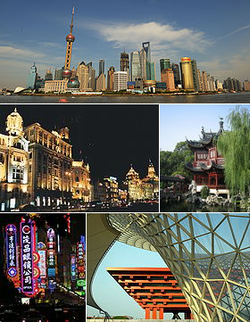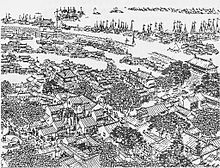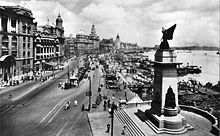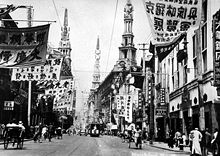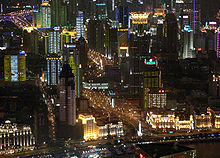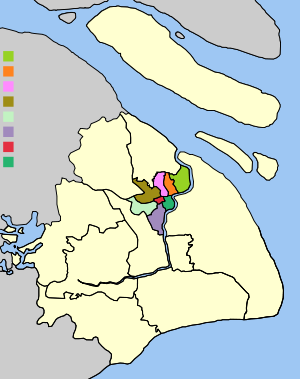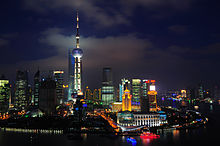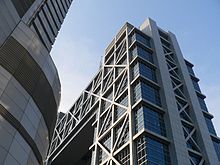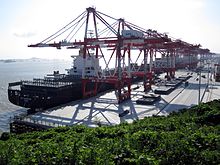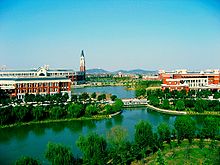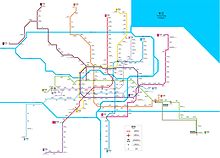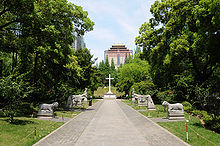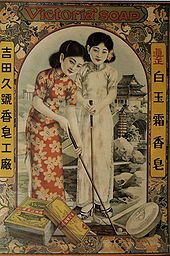- Shanghai
-
Shanghai
上海— Municipality — Municipality of Shanghai • 上海市 Clockwise from top: A view of the Pudong skyline; Yuyuan Garden, China Pavilion along with the Expo Axis, neon signs on Nanjing Road, and The Bund Location of Shanghai Municipality within China Coordinates: 31°12′N 121°30′E / 31.2°N 121.5°ECoordinates: 31°12′N 121°30′E / 31.2°N 121.5°E Country People's Republic of China Settled 5th–7th century Incorporated
- Town
751- County 1292 - Municipality 7 July 1927 Divisions
- County-level
- Township-
level
16 districts, 1 county
210 towns and subdistrictsGovernment - Type Municipality - CPC Ctte Secretary Yu Zhengsheng - Mayor Han Zheng Area[1][2] - Municipality 6,340.5 km2 (2,448.1 sq mi) - Water 697 km2 (269.1 sq mi) Elevation[3] 4 m (13 ft) Population (2010)[4] - Municipality 23,019,148 - Density 3,630.5/km2 (9,402.9/sq mi) Demonym Shanghainese Time zone China standard time (UTC+8) Postal code 200000 – 202100 Area code(s) 21 GDP[5] 2010 - Total CNY 1.687 trillion
US$ 256.3 billion (9th)- Per capita CNY 73,287
US$ 11,134 (1st)- Growth  9.9%
9.9%HDI (2008) 0.908 (1st) – very high Licence plate prefixes 沪A, B, D, E, F,G ,H, J, K
沪C (outer suburbs)City flower Yulan magnolia Website www.shanghai.gov.cn Shanghai (Chinese: 上海; Shanghainese: Zånhae; Mandarin pinyin: Shànghǎi) is the largest city by population in China[6][7] and the largest city proper in the world.[8] It is one of the four province-level municipalities in the People's Republic of China, with a total population of over 23 million as of 2010.[4] Due to its rapid development over the last two decades it has again become a leading global city, with significant influence in commerce, culture, finance, media, fashion, technology and transport. Shanghai is now a major financial center[9] and the busiest container port in the world.[10]
Located in the Yangtze River Delta in eastern China, Shanghai sits at the mouth of the Yangtze River in the middle portion of the Chinese coast. The municipality borders Jiangsu and Zhejiang Provinces to the west, and is bounded to the east by the East China Sea.[11]
Once a fishing and textiles town, Shanghai grew in importance in the 19th century due to its favorable port location and was one of the cities opened to foreign trade by the 1842 Treaty of Nanking. The city then flourished as a center of commerce between east and west, and became the undisputed financial hub of the Asia Pacific in the 1930s.[12] However, with the Communist Party takeover of the mainland in 1949, the city's international influence declined. In the 1990s, the economic reforms introduced by Deng Xiaoping resulted in an intense re-development of the city, aiding the return of finance and foreign investment to the city.[13]
Shanghai is also a popular tourist destination renowned for its historical landmarks such as The Bund, City God Temple and Yuyuan Garden, as well as the extensive and growing Pudong skyline. It is described as the "showpiece" of the booming economy of mainland China.[14][15]
Contents
Etymology and names
Shanghai 
"Shanghai", as written in Chinese Chinese 上 海 Wu Zaonhe Literal meaning above sea or on sea Transcriptions Hakka - Romanization Sông-hói Mandarin - Hanyu Pinyin Shànghǎi Min - Hokkien POJ Siōng-hái - Min-dong BUC Siông-hāi Wu - Romanization Zaonhe - Shanghainese
romanizationZånhae IPA: [z̥ɑ̃̀hé] Cantonese (Yue) - Jyutping soeng6hoi2 The two Chinese characters in the city's name are 上 ("above") and 海 ("sea"), together meaning "Upon-the-Sea". The earliest occurrence of this name dates from the 11th century Song Dynasty, at which time there was already a river confluence and a town with this name in the area. There are disputes as to exactly how the name should be interpreted, but Chinese historians have concluded that during the Tang Dynasty Shanghai was literally on the sea, hence the origin of the name.[16] Older Chinese was written right-to-left, so a reversed order "海上" is sometimes used for terms related to Shanghainese art and culture.[citation needed]
Shanghai is officially abbreviated 沪 (Hù) in Chinese,[17] a contraction of 沪渎 (Hù Dú, lit "Harpoon Ditch"),[18][19] a 4th or 5th century Jin name for the mouth of Suzhou Creek when it was the main conduit into the ocean.[18] This character appears on all motor vehicle license plates issued in the municipality today.
An older name for Shanghai is Shēn (申), from Chunshen Jun (春申君), a nobleman and locally-revered hero of the third-century BC state of Chu. From this, it is also called Shēnchéng (申城, "Shen City").[18] Sports teams and newspapers in Shanghai often use this character in their names.
Another early name for Shanghai was Huating (华亭). In 751 AD, during the mid-Tang Dynasty, Huating County was established at modern-day Songjiang, the first county-level administration within modern-day Shanghai. Today, Huating appears as the name of a four-star hotel in the city.[16]
The city has also has various nicknames in English, including "Paris of the East".[20]
History
During the Song Dynasty (AD 960–1279) Shanghai was upgraded in status from a village to a market town in 1074, and in 1172 a second sea wall was built to stabilize the ocean coastline, supplementing an earlier dyke.[21] From the Yuan Dynasty in 1292 until Shanghai officially became a city for the first time in 1927, the area was designated merely as a county seat administered by the Songjiang prefecture.[22]
Two important events helped promote Shanghai's development in the Ming Dynasty. A city wall was built for the first time in 1554 to protect the town from raids by Japanese pirates. It measured 10 metres high and 5 kilometres in circumference.[23] During the Wanli reign (1573–1620), Shanghai received an important psychological boost from the erection of a City God Temple in 1602. This honour was usually reserved for places with the status of a city, such as a prefectural capital not normally given to a mere county town, as Shanghai was. It probably reflected the town's economic importance, as opposed to its low political status.[23]
During the Qing Dynasty, Shanghai became one of the most important sea ports in the Yangtze Delta region as a result of two important central government policy changes: First, Emperor Kangxi (1662–1723) in 1684 reversed the previous Ming Dynasty prohibition on ocean going vessels – a ban that had been in force since 1525. Second, in 1732 Emperor Yongzheng moved the customs office for Jiangsu province (江海关; see Customs House, Shanghai) from the prefectural capital of Songjiang city to Shanghai, and gave Shanghai exclusive control over customs collections for Jiangsu Province's foreign trade. As a result of these two critical decisions, Professor Linda Cooke Johnson has concluded that by 1735 Shanghai had become the major trade port for all of the lower Yangtze River region, despite still being at the lowest administrative level in the political hierarchy.[24]
International attention to Shanghai grew in the 19th century due to its economic and trade potential at the Yangtze River. During the First Opium War (1839–1842), British forces temporarily held the city. The war ended with the 1842 Treaty of Nanjing, opening the treaty ports, Shanghai included, for international trade. The Treaty of the Bogue signed in 1843, and the Sino-American Treaty of Wanghia signed in 1844 together allowed foreign nations to visit and trade on Chinese soil, and Britain, France, and the United States all carved out concessions outside the walled city of Shanghai, which was still ruled by the Chinese.
The Chinese-held old city of Shanghai fell to the rebels of the Small Swords Society in 1853 but was recovered by the Qing in February 1855.[25] In 1854, the Shanghai Municipal Council was created to manage the foreign settlements. Between 1860–1862, the Taiping rebels twice attacked Shanghai and destroyed the city's eastern and southern suburbs, but failed to take the city.[26] In 1863, the British settlement to the south of Suzhou Creek (northern Huangpu District) and the American settlement to the north (southern Hongkou District) joined in order to form the Shanghai International Settlement. The French opted out of the Shanghai Municipal Council and maintained its own concession to the south and southwest.
Citizens of many countries and all continents came to Shanghai to live and work during the ensuing decades; those who stayed for long periods – some for generations – called themselves "Shanghailanders".[27] In the 1920s and 1930s, almost 20,000 White Russians and Russian Jews fled the newly established Soviet Union and took up residence in Shanghai. These Shanghai Russians constituted the second-largest foreign community. By 1932, Shanghai had become the world's fifth largest city and home to 70,000 foreigners.[28] In the 1930s, some 30,000 Jewish refugees from Europe arrived in the city.[29]
The Sino-Japanese War concluded with the Treaty of Shimonoseki, which elevated Japan to become another foreign power in Shanghai. Japan built the first factories in Shanghai, which were soon copied by other foreign powers. Shanghai was then the most important financial center in the Far East. All this international activity gave Shanghai the nickname "the Great Athens of China"[30]
Under the Republic of China (1911–1949), Shanghai's political status was finally raised to that of a municipality on 14 July 1927. Although the territory of the foreign concessions was excluded from their control, this new Chinese municipality still covered an area of 828.8 square kilometers, including the modern-day districts of Baoshan, Yangpu, Zhabei, Nanshi, and Pudong. Headed by a Chinese mayor and municipal council, the new city governments first task was to create a new city-center in Jiangwan town of Yangpu district, outside the boundaries of the foreign concessions. This new city-center was planned to include a public museum, library, sports stadium, and city hall.[31]
On 28 January 1932, Japanese forces struck and the Chinese resisted, fighting to a standstill; a ceasefire was brokered in May. The Battle of Shanghai in 1937 resulted in the occupation of the Chinese administered parts of Shanghai outside of the International Settlement and the French Concession. The International Settlement was occupied by the Japanese on 8 December 1941 and remained occupied until Japan's surrender in 1945, during which time war crimes were committed.[32]
On 27 May 1949, the People's Liberation Army took control of Shanghai, which was one of only three former Republic of China (ROC) municipalities not merged into neighboring provinces over the next decade (the others being Beijing and Tianjin).[33] Shanghai underwent a series of changes in the boundaries of its subdivisions, especially in the next decade. After 1949, most foreign firms moved their offices from Shanghai to Hong Kong, as part of an exodus of foreign investment due to the Communist victory.
During the 1950s and 1960s, Shanghai became an industrial center and center for radical leftism; the leftist Jiang Qing and her three cohorts, together the Gang of Four, were based in the city.[34] Yet, even during the most tumultuous times of the Cultural Revolution, Shanghai was able to maintain high economic productivity and relative social stability. In most of the history of the People's Republic of China (PRC), in order to funnel wealth to the rural areas, Shanghai has been a comparatively heavy contributor of tax revenue to the central government. This came at the cost of severely crippling Shanghai's infrastructural and capital development. Its importance to the fiscal well-being of the central government also denied it economic liberalizations begun in 1978. Shanghai was finally permitted to initiate economic reforms in 1991, starting the massive development still seen today and the birth of Lujiazui in Pudong.
Geography
 The Yangtze River Delta is shown in green in this map of Shanghai (on the east at center) alongside the neighboring provinces of Jiangsu (to the north and west) and Zhejiang (to the south and west). Parts of Jiangsu and Zhejiang which are outside the Yangtze River Delta are shown in yellow. Provincial boundaries are shown in purple, sub-provincial boundaries in grey.
The Yangtze River Delta is shown in green in this map of Shanghai (on the east at center) alongside the neighboring provinces of Jiangsu (to the north and west) and Zhejiang (to the south and west). Parts of Jiangsu and Zhejiang which are outside the Yangtze River Delta are shown in yellow. Provincial boundaries are shown in purple, sub-provincial boundaries in grey.
Shanghai sits on the Yangtze River Delta on China's eastern coast, and is roughly equidistant from Beijing and Hong Kong. The municipality as a whole consists of a peninsula between the Yangtze and Hangzhou Bay, mainland China's second-largest island Chongming, and a number of smaller islands. It is bordered on the north and west by Jiangsu Province, on the south by Zhejiang Province, and on the east by the East China Sea. The city proper is bisected by the Huangpu River, a tributary of the Yangtze. The historic center of the city, the Puxi area, is located on the western side of the Huangpu, while the newly developed Pudong, containing the central financial district Lujiazui, was developed on the eastern bank.
The vast majority of Shanghai's 6,340.5 km2 (2,448.1 sq mi) land area is flat, apart from a few hills in the southwest corner, with an average elevation of 4 m (13 ft).[3] The city's location on the flat alluvial plain has meant that new skyscrapers must be built with deep concrete piles to stop them from sinking into the soft ground. The highest point is at the peak of Dajinshan Island at 103 m (338 ft).[3] The city has many rivers, canals, streams and lakes and is known for its rich water resources as part of the Taihu drainage area.[2]
Climate
Shanghai has a humid subtropical climate (Köppen Cfa) and experiences four distinct seasons. Winters are chilly and damp, and cold northwesterly winds from Siberia can cause nighttime temperatures to drop below freezing, although most years there are only one or two days of snowfall. Summers are hot and humid, with an average of 8.7 days exceeding 35 °C (95 °F) annually; occasional downpours or freak thunderstorms can be expected. The city is also susceptible to typhoons in summer and the beginning of autumn, none of which in recent years has caused considerable damage.[35] The most pleasant seasons are Spring, although changeable and often rainy, and Autumn, which is generally sunny and dry. The city averages 4.2 °C (39.6 °F) in January and 27.9 °C (82.2 °F) in July, for an annual mean of 16.1 °C (61.0 °F). Shanghai experiences on average 1,878 hours of sunshine per year, with the hottest temperature ever recorded at 40.2 °C (104 °F), and the lowest at −12.1 °C (10 °F).[36]
Climate data for 上海 (1971−2000) Month Jan Feb Mar Apr May Jun Jul Aug Sep Oct Nov Dec Year Average high °C (°F) 8.1
(46.6)9.2
(48.6)12.8
(55.0)19.1
(66.4)24.1
(75.4)27.6
(81.7)31.8
(89.2)31.3
(88.3)27.2
(81.0)22.6
(72.7)17.0
(62.6)11.1
(52.0)20.2 Average low °C (°F) 1.1
(34.0)2.2
(36.0)5.6
(42.1)10.9
(51.6)16.1
(61.0)20.8
(69.4)25.0
(77.0)24.9
(76.8)20.6
(69.1)15.1
(59.2)9.0
(48.2)3.0
(37.4)12.9 Precipitation mm (inches) 50.6
(1.992)56.8
(2.236)98.8
(3.89)89.3
(3.516)102.3
(4.028)169.6
(6.677)156.3
(6.154)157.9
(6.217)137.3
(5.406)62.5
(2.461)46.2
(1.819)37.1
(1.461)1,164.7
(45.854)% humidity 75 74 76 76 76 82 82 81 78 75 74 73 76.8 Avg. precipitation days (≥ 0.1 mm) 9.7 10.3 13.9 12.7 12.1 14.4 12.0 11.3 11.0 8.1 7.0 6.5 129.0 Sunshine hours 123.0 115.7 126.0 156.1 173.5 147.6 217.8 220.8 158.9 160.8 146.6 147.7 1,894.5 Source: China Meteorological Administration [37] Politics
Like virtually all governing institutions in mainland China, the politics of Shanghai is structured in a dual party-government system,[38] in which the Communist Party Chief, officially termed the Communist Party of China Shanghai Municipal Committee Secretary (currently Yu Zhengsheng), outranks the Mayor (currently Han Zheng).
Political power in Shanghai is widely seen as a stepping stone to higher positions in the national government. Since Jiang Zemin became the national party chief in June 1989, all but one former Shanghai party chief was elevated to the Politburo Standing Committee, the de facto highest decision-making body in China[38], including Jiang Zemin (General secretary and President)[39], Zhu Rongji (Premier)[40], Wu Bangguo (Chairman of the National People's Congress)[41], Huang Ju (Vice Premier)[42], and Xi Jinping (Vice President)[43]. Zeng Qinghong, a former deputy party chief of Shanghai, also rose to the Politburo Standing Committee and became the Vice President and an influential power broker[44]. The only exception is Chen Liangyu, who was fired in 2006 and later convicted of corruption[45]. Officials with ties to the Shanghai administration form a powerful faction in the national government, the so-called Shanghai Clique, which often competes against the rival Youth League Faction over personnel appointments and policy decisions:[46] Xi Jinping, the presumptive successor to Hu Jintao as General Secretary and President, is a compromise candidate between the two groups with supporters in both camps.
Administrative divisions
Shanghai is administratively equal to a province and is divided into 17 county-level divisions: 16 districts and one county. Even though every district has its own urban core, the real city center is between Bund to the east, Nanjing Rd to the north, Old City Temple and Huaihai Road to the south. Prominent central business areas include Lujiazui on the east bank of the Huangpu River, and The Bund and Hongqiao areas in the west bank of the Huangpu River. The city hall and major administration units are located in Huangpu District, which also serve as a commercial area, including the famous Nanjing Road. Other major commercial areas include Xintiandi and the classy Huaihai Road (previously Avenue Joffre) in Luwan district and Xujiahui (formerly rendered in English as Zikawei, reflecting the Shanghainese pronunciation) in Xuhui District. Many universities in Shanghai are located in residential areas of Yangpu District and Putuo District.
Puxi:BaoshanEight of the districts govern Puxi (lit "Huangpu West Bank"), the older part of urban Shanghai on the west bank of the Huangpu River. These eight districts are collectively referred to as Shanghai Proper (上海市区) or the core city (市中心):
- Huangpu District (黄浦区 Huángpǔ Qū) – merged with Nanshi District in 2000, and Luwan District in 2011
- Xuhui District (徐汇区 Xúhuì Qū)
- Changning District (长宁区 Chángníng Qū)
- Jing'an District (静安区 Jìng'ān Qū)
- Putuo District (普陀区 Pǔtuó Qū)
- Zhabei District (闸北区 Zháběi Qū)
- Hongkou District (虹口区 Hóngkǒu Qū)
- Yangpu District (杨浦区 Yángpǔ Qū)
Pudong (lit "Huangpu East Bank"), the newer part of urban and suburban Shanghai on the east bank of the Huangpu River, is governed by:
- Pudong New District (浦东新区 Pǔdōng Xīn Qū) – Chuansha County until 1992, merged with Nanhui District in 2009
Seven of the districts govern suburbs, satellite towns, and rural areas further away from the urban core:
- Baoshan District (宝山区 Bǎoshān Qū) – Baoshan County until 1988
- Minhang District (闵行区 Mǐnháng Qū) – Shanghai County until 1992
- Jiading District (嘉定区 Jiādìng Qū) – Jiading County until 1992
- Jinshan District (金山区 Jīnshān Qū) – Jinshan County until 1997
- Songjiang District (松江区 Sōngjiāng Qū) – Songjiang County until 1998
- Qingpu District (青浦区 Qīngpǔ Qū) – Qingpu County until 1999
- Fengxian District (奉贤区 Fèngxián Qū) – Fengxian County until 2001
Chongming Island, an island at the mouth of the Yangtze, is governed by:
- Chongming County (崇明县 Chóngmíng Xiàn)
As of 2009, these county-level divisions are further divided into the following 210 township-level divisions: 109 towns, 2 townships, 99 subdistricts. Those are in turn divided into the following village-level divisions: 3,661 neighborhood committees and 1,704 village committees.[47]
Economy
Shanghai is the commercial and financial center of mainland China, and ranks fifth in the 2011 edition of the Global Financial Centres Index published by the City of London.[48]. It was the largest and most prosperous city in the Far East during the 1930s, and rapid re-development began in 1990s.[12] This is exemplified by the Pudong District, which became a pilot area for integrated economic reforms. By the end of 2009, there were 787 financial institutions, of which 170 were foreign-invested.[49] In 2009, the Shanghai Stock Exchange ranked third among worldwide stock exchanges in terms of trading volume and sixth in terms of the total capitalization of listed companies, and the trading volume of six key commodities including rubber, copper and zinc on the Shanghai Futures Exchange all ranked first in the world.[50]
In the last two decades Shanghai has been one of the fastest developing cities in the world. Since 1992 Shanghai has recorded double-digit growth almost every year except during the global recession of 2008 and 2009.[51] In 2010, Shanghai's total GDP grew to 1.687 trillion RMB (US$256.3 billion) with GDP per capita of 76,000 RMB ($11,540).[5] The three largest service industries are financial services, retail, and real estate. The manufacturing and agricultural sectors accounted for 39.9 percent and 0.7 percent of the total output respectively.[49] Average annual disposable income of Shanghai residents, based on the first three quarters of 2009, was 21,871 RMB.[52]
Located at the heart of the Yangtze River Delta, Shanghai has the world’s busiest container port, which handled 29.05 million TEUs in 2010.[10] Shanghai aims to be an international shipping center in the near future.[53]
Shanghai is one of the main industrial centers of China, playing a key role in China’s heavy industries. A large number of industrial zones, including Shanghai Hongqiao Economic and Technological Development Zone, Jinqiao Export Economic Processing Zone, Minhang Economic and Technological Development Zone, and Shanghai Caohejing High-Tech Development Zone, are backbones of Shanghai's secondary industry. Heavy industries accounted for 78% of the gross industrial output in 2009. China’s largest steelmaker Baosteel Group and Jiangnan Shipyard, one of China's oldest shipbuilders are both located in Shanghai.[54] Auto manufacture is another important industry. Shanghai Automotive Industry Corporation (Group) ("SAIC" for short) is one of the top 3 automotive corporations in China. The company has a strategic partnership with Volkswagen and General Motors.[55]
Demographics
Historical populations Year Pop. ±% 1953 6,204,400 — 1964 10,816,500 +74.3% 1982 11,859,700 +9.6% 1990 13,341,900 +12.5% 2000 16,407,700 +23.0% 2010 23,019,200 +40.3% Population size may be affected by changes on administrative divisions. Source: [56] The 2010 census put Shanghai's total population at 23,019,148, a growth of 37.53% from 16,737,734 in 2000.[4][57] 20.6 million of the total population, or 89.3%, are urban, and 2.5 million (10.7%) are rural.[58] Based on population of total administrative area, Shanghai is the second largest of the four direct-controlled municipalities of China, behind Chongqing, but is generally considered the largest city in China because Chongqing's urban population is much smaller.[6]
Shanghai's 2010 population of 23 million includes 8.997 million long-term migrants, almost triple the 3.06 million in 2000.[59] They account for almost the entire increase in Shanghai's population as its natural growth rate has been negative since 1993 due to low fertility rate.[60] The main origins of these "new Shanghainese" are Anhui (29.0%), Jiangsu (16.8%), Henan (8.7%), and Sichuan (7.0%) provinces, and 79% are from rural areas.[59]
98.8% Of Shanghai's residents are of the Han Chinese ethnicity, while 1.2% belong to various minority groups. However, the minority population has grown by 165.54% since 2000, much faster than the overall population growth.[57]
According to the Shanghai Municipal Statistics Bureau, there were 152,050 officially registered foreigners in Shanghai as of 2009, an increase of 50% from 100,011 in 2005. The three largest foreign nationalities were Japanese (31,490), American (21,284) and Korean (20,700).[61] Note that these statistics only show officially registered residents, and that the actual number of foreign citizens living in Shanghai is likely much higher. For example by 2009, the South Korean community in Shanghai increased to more than 70,000 according to Xinhua.[62] Some foreign expatriates are staying in Shanghai as long-term settlers, renewing Shanghai's reputation as China's global city.[63] In addition, there are a large number of people from Taiwan living within the municipality (2010 estimates vary around 700,000).[64]
The life expectancy of Shanghai's registered residents in 2010 reached 82.13 years (79.82 for men and 84.44 for women), the highest in mainland China and higher than all but a few countries in the world. In the same year, the maternal mortality rate in Shanghai was 9.61 per 100,000, while the infant mortality rate dropped to 5.97 per 1,000 from 6.58 in 2009.[65] Due to the combination of high life expectancy and low fertility rate, there is a serious aging problem among Shanghai's registered residents: as of 2009 only 8.3% of the total were under the age of 14, while 22.54% were over 60.[66]
Religion
Due to its cosmopolitan history, Shanghai has a rich blend of religious heritage as shown by the religious buildings and institutions still scattered around the city. Taoism has a presence in Shanghai in the form of several temples, including the City God Temple, at the heart of the old city, and a temple dedicated to the Three Kingdoms general Guan Yu. The Wenmiao is a temple dedicated to Confucius. Buddhism has had a presence in Shanghai since ancient times. Longhua temple, the largest temple in Shanghai, and Jing'an Temple, were first founded in the Three Kingdoms period. Another important temple is the Jade Buddha Temple, which is named after a large statue of Buddha carved out of jade in the temple. In recent decades, dozens of modern temples have been built throughout the city. A predominant religion in Shanghai is Mahayana Buddhism, and Taoism is also followed by many Shanghai residents. Islam came into Shanghai 700 years ago and a mosque was built in 1295 in Songjiang. In 1843, a teachers' college was also set up. The Xiaotaoyuan Mosque is located at 52 Xiaotaoyuan Lane,East Fuxing Road, South District. This is where the Shanghai Muslim Association is also located, which has a reputation known throughout the world. Shanghai has the highest Catholic percentage in Mainland China (2003).[67] Among Catholic churches, St Ignatius Cathedral in Xujiahui is one of the largest, while She Shan Basilica is the only active pilgrimage site in China. communities. Christianity in Shanghai includes Eastern Orthodox minorities and, since 1996, registered Christian Protestant churches. During World War II thousands of Jews descended upon Shanghai in an effort to flee Hitler’s regime. The Jews lived side-by-side in a designated area called Shanghai Ghetto and formed a vibrant community centered on the Ohel Moshe Synagogue, which is preserved remnant of this portion of Shanghai’s complex religious past.[68]
Education
Shanghai has one of the best education systems in China. It is the first city in the country to implement 9-year mandatory education. The 2010 census shows that out of Shanghai's total population, 22.0% had a college education, double the level from 2000, while 21.0% had high school, 36.5% middle school, and 1.35% primary school education. 2.74% of residents age 15 and older were illiterate.[69]
Shanghai has more than 930 kindergartens, 1,200 primary and 850 middle schools. Over 760,000 middle schools students and 871,000 primary school students are taught by 76,000 and 64,000 teaching staff respectively.[70]
Shanghai is a major center of higher education in China with over 30 universities and colleges. A number of China's most prestigious universities are based in Shanghai, including Fudan University, Shanghai Jiao Tong University, Tongji University, East China Normal University, Shanghai International Studies University, and Shanghai University of Finance and Economics.
In 2010, Shanghai took the top spot in the latest round of the most comprehensive assessment of the world’s state schools. According to Program for International Student Assessment (PISA) results, Shanghai students, including migrant children, scored highest in every aspect (Math, Reading and Science) in the world. The study also claimed that public-funded schools in Shanghai have the highest educational quality in the world.[71][72]
Transport
Public transport
See also: Public transport in ShanghaiShanghai has an extensive public transport system, largely based on metros, buses and taxis. Payment of all these public transportation tools can be made by using the Shanghai Public Transportation Card.
Shanghai's rapid transit system, the Shanghai Metro, incorporates both subway and light railway lines and extends to every core urban district as well as neighboring suburban districts.
As of 2010, there are twelve metro lines (including the Shanghai Maglev Train), 273 stations and over 420 km of tracks in operation, making it the longest network in the world.[73] On 22 October 2010, it set a record of daily ridership of 7.548 million.[74] The fare depends on the length of travel distance starting from 3 RMB.
Shanghai also has the world's most extensive network of urban bus routes, with nearly one thousand bus lines, operated by numerous transportation companies.[75] The system includes the world's oldest trolleybus system. Bus fare normally costs 2 RMB.
Taxis are plentiful in Shanghai. The base fare is currently ¥14 (inclusive of a ¥1 fuel surcharge; ¥18 between 11:00 pm and 5:00 am) which covers the first 3 kilometers. Additional kilometers cost ¥2.4 each (¥3.2 between 11:00 pm and 5:00 am).[76]
Roads
Shanghai is a major hub of China's expressway network. Many national expressways (prefixed with G) pass through or terminate in Shanghai, including G2 Beijing–Shanghai Expressway (overlapping G42 Shanghai–Chengdu), G15 Shenyang–Haikou, G40 Shanghai–Xi'an, G50 Shanghai–Chongqing, G60 Shanghai–Kunming (overlapping G92 Shanghai–Ningbo), and G1501 Shanghai Ring Expressway. In addition, there are also numerous municipal expressways prefixed with S (S1, S2, S20, etc.). In the city center, there are several elevated expressways to lessen traffic pressure on surface streets, but traffic in and around Shanghai is often heavy and traffic jams are commonplace during rush hour. There are bicycle lanes separate from car traffic on many surface streets, but bicycles and motorcycles are banned from most main roads including the elevated expressways.
Private car ownership in Shanghai has been rapidly increasing in recent years, but a new private car cannot be driven until the owner buys a license in the monthly private car license plate auction. Around 8,000 license plates are auctioned each month and the average price is about 45,291 RMB (€5,201). The purpose of this policy is to limit the growth of automobile traffic and to alleviate congestion.[77]
Railway
Shanghai has three major railway stations: Shanghai Railway Station, Shanghai South Railway Station, and Shanghai Hongqiao Railway Station. All three are connected to the metro network and serve as hubs in the railway network of China. Two main railways terminate in Shanghai: Jinghu Railway from Beijing, and Huhang Railway from Hangzhou. Hongqiao Station also serves as the main Shanghai terminus of three high-speed rail lines: the Shanghai–Hangzhou High-Speed Railway, the Shanghai–Nanjing High-Speed Railway, and the Beijing–Shanghai High-Speed Railway, China's most important high-speed rail line.
Air
Shanghai is one of the leading air transport gateways in Asia. The city has two commercial airports: Shanghai Pudong International Airport and Shanghai Hongqiao International Airport.[78] Pudong Airport is the main international airport, while Hongqiao Airport mainly operates domestic flights with limited short-haul international flights. In 2010 the two airports served 71.7 million passengers (Pudong 40.4 million, Hongqiao 31.3 million), and handled 3.7 million tons of cargo (Pudong 3.22 million tons, Hongqiao 480 thousand tons).[79]
Architecture

Shanghai has a rich collection of buildings and structures of various architectural styles. The Bund, located by the bank of the Huangpu River, contains a rich collection of early 20th-century architecture, ranging in style from neoclassical HSBC Building to the art deco Sassoon House. A number of areas in the former foreign concessions are also well-preserved, the most notable ones being the French Concession. Shanghai has one of the worlds largest number of Art Deco buildings as a result of the construction boom during the 1920s and 1930s. One of the most famous architects working in Shanghai was László Hudec, an Hungarian-Slovak architect who lived in the city between 1918–1947. Some of his most notable Art Deco buildings include the Park Hotel and the Grand Theater. Other prominent architects who contributed to the Art Deco style are Parker & Palmer, who designed the Peace Hotel, Metropole Hotel, and the Broadway Mansions, and Austrian architect GH Gonda who designed the Capital Theatre. The Bunds first revitalization started in 1986 with a new promenade by the Architect Snoeren, the completion was in the mid-1990s.
Despite rampant redevelopment, the old city still retains some buildings of a traditional style, such as the Yuyuan Garden, an elaborate traditional garden in the Jiangnan style.
In recent years, a large number of architecturally distinctive and even eccentric buildings have sprung up throughout Shanghai. Notable examples of contemporary architecture include the Shanghai Museum, Shanghai Grand Theatre in the People's Square precinct and Shanghai Oriental Art Center.
One uniquely Shanghainese cultural element is the shikumen (石库门) residences, which are two- or three-story townhouses, with the front yard protected by a high brick wall. Each residence is connected and arranged in straight alleys, known as a lòngtang (弄堂), pronounced longdang in Shanghainese. The entrance to each alley is usually surmounted by a stylistic stone arch. The whole resembles terrace houses or townhouses commonly seen in Anglo-American countries, but distinguished by the tall, heavy brick wall in front of each house. The name "shikumen" means "stone storage door", referring to the strong gateway to each house.
The shikumen is a cultural blend of elements found in Western architecture with traditional Lower Yangtze (Jiangnan) Chinese architecture and social behavior. All traditional Chinese dwellings had a courtyard, and the shikumen was no exception. Yet, to compromise with its urban nature, it was much smaller and provided an "interior haven" to the commotions in the streets, allowing for raindrops to fall and vegetation to grow freely within a residence. The courtyard also allowed sunlight and adequate ventilation into the rooms.
The city also has some beautiful examples of Soviet neoclassical architecture. These buildings were mostly erected during the period from the founding of the People's Republic in 1949 until the Sino-Soviet Split in the late 1960s. During this decade, large numbers of Soviet experts, including architects, poured into China to aid the country in the construction of a communist state. Examples of Soviet neoclassical architecture in Shanghai include what is today the Shanghai International Exhibition Center. Beijing, the nation's capital, displays an even greater array of this particular type of architecture.
The Pudong district of Shanghai displays a wide range of skyscrapers, many of which rank among the tallest in the world. The most prominent examples include the Jin Mao Tower and the taller Shanghai World Financial Center, which at 492 metres tall is the tallest skyscraper in mainland China and ranks third in the world. The distinctive Oriental Pearl Tower, at 468 metres, is located nearby, and its lower sphere is now available for living quarters. Another highrise in the Pudong area is the newly finished Development Tower, standing at 269 meters.[80]
Since 2008, Shanghai has boasted more free-standing buildings above 400m (3) than any other city. In the future, the Shanghai Tower, slated for completion in 2014, will be the tallest building in China. With a height of 632 metres (2074 feet), the building will have 127 floors and a total floor area of 380,000 sqm. The Shanghai Tower began construction in 2008.[81]
Environment
Parks and resorts
Shanghai's parks offer some reprieve from the urban jungle. Due to the scarcity of play space for children, nearly all parks have a children's section. Fuxing Park, in the former French Concession of Shanghai, features formal French-style gardens and is surrounded by high end bars and cafes. Zhongshan Park in northwestern central Shanghai is famous for its monument of Chopin, the tallest statue dedicated to the composer in the world. Built in 1914 as Jessfield Park, it once contained the campus of St. John's University, Shanghai's first international college; today, it is known for its extensive rose and peony gardens, a large children's play area, and as the location of an important transfer station on the city's metro system. One of the newest is in the Xujiahui area – Xujiahui Park, built in 1999 on the former grounds of the Great Chinese Rubber Works Factory and the EMI Recording Studio (now La Villa Rouge restaurant). The park has a man-made lake with a sky bridge running across the park, and offers a pleasant respite for Xujiahui shoppers.
The Shanghai Disneyland Resort Project was approved by the government on 4 November 2009.[82] It is currently under construction. The resort is planned to be operational by 2013.[83] A $4.4 billion theme park and resort in Pudong will have a castle that will be the biggest among Disney's resorts.[84]
Environmental protection
Public awareness of the environment is growing, and the city is investing in a number of environmental protection projects. A 10-year, US$1 billion cleanup of Suzhou Creek, which runs through the city-center, was expected to be finished in 2008,[85] and the government also provides incentives for transportation companies to invest in LPG buses and taxis. Air pollution in Shanghai is low compared to other Chinese cities, but the rapid development over the past decades means it is still high on worldwide standards. The government has moved almost all factories within downtown to either outskirts of Shanghai or the neighboring Jiangsu and Zhejiang Provinces in the last two decades. In addition, several parks have been built in the city. As a result, Shanghai's air quality has been steadily improving since 1990s.[86]
Culture
 The Mercedes-Benz Arena, previously known as the Expo Cultural Center during the world expo in 2010.
The Mercedes-Benz Arena, previously known as the Expo Cultural Center during the world expo in 2010.
Because of Shanghai's status as the cultural and economic center of East Asia for the first half of the twentieth century, it is popularly seen as the birthplace of everything considered modern in China. It was in Shanghai, for example, that the first motor car was driven and (technically) the first train tracks and modern sewers were laid. It was also the intellectual battleground between socialist writers who concentrated on critical realism, which was pioneered by Lu Xun, Mao Dun, Nien Cheng and the famous French novel by André Malraux, Man's Fate, and the more "bourgeois", more romantic and aesthetically inclined writers, such as Shi Zhecun, Shao Xunmei, Ye Lingfeng, and Eileen Chang.
Language
Most Shanghai residents are the descendants of immigrants from the two adjacent provinces of Jiangsu and Zhejiang who moved to Shanghai in the late nineteenth and early twentieth centuries, regions whose population, in general, also speak Wu Chinese. In the past decades, many migrants from other areas of China not mentioned above have come to Shanghai for work. They often cannot speak the local language and therefore use Mandarin as a lingua franca.
The vernacular language is Shanghainese, a dialect of Wu Chinese, while the official language nationwide is Mandarin. The local language is mutually unintelligible with Mandarin, and is thus an inseparable part of the Shanghainese identity. The modern Shanghainese language is based on the Suzhou dialect of Wu, the prestige dialect of Wu spoken within the Chinese city of Shanghai prior to the modern expansion of the city, the Ningbo dialect of Wu, and the dialect of Shanghai's traditional areas now within the Hongkou, Baoshan and Pudong districts, which is simply called "the local tongue" (本地话). It is influenced to a lesser extent by the languages of other nearby regions from which large numbers of people have migrated to Shanghai since the 20th century, and includes a significant number of terms borrowed from European languages. The prevalence of Mandarin fluency is generally higher for those born after 1949 than those born before, while the prevalence of English fluency is higher for people who received their secondary and tertiary education before 1949 than those who did so after 1949 and before the 1990s.
Museums
Shanghai boasts several museums of regional and national importance. The Shanghai Museum of art and history has one of the best collections of Chinese historical artifacts in the world, including important archaeological finds since 1949. The Shanghai Art Museum, located in the former Shanghai Race Club building in the People's Square, is a major art museum holding both permanent and temporary exhibitions. The Shanghai Natural History Museum is a large scale natural history museum. In addition, there is a variety of smaller, specialist museums, some housed in important historical sites such as the site of the Provisional Government of the Republic of Korea and the site of the First National Congress of the Communist Party of China.
Cinema
Besides literature, Shanghai was also the birthplace of Chinese cinema and theater. China’s first short film, The Difficult Couple (難夫難妻, Nanfu Nanqi, 1913), and the country’s first fictional feature film, An Orphan Rescues His Grandfather (孤兒救祖記, Gu'er Jiu Zuji, 1923) were both produced in Shanghai. These two films were very influential, and established Shanghai as the center of Chinese film-making. Shanghai’s film industry went on to blossom during the early 1930s, generating Marilyn Monroe-like stars such as Zhou Xuan. Another film star, Jiang Qing, went on to become Madame Mao Zedong. The talent and passion of Shanghainese filmmakers following World War II and the Communist revolution in China contributed enormously to the development of the Hong Kong film industry. Many aspects of Shanghainese popular culture ("Shanghainese Pops") were transferred to Hong Kong by the numerous Shanghainese emigrants and refugees after the Communist Revolution. The movie In the Mood for Love, which was directed by Wong Kar-wai (a native Shanghainese himself), depicts one slice of the displaced Shanghainese community in Hong Kong and the nostalgia for that era, featuring 1940s music by Zhou Xuan.
Arts
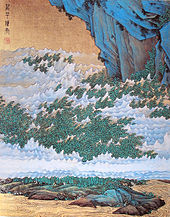 十萬圖之四 (No. 4 of a Hundred Thousand Scenes) by Ren Xiong, a pioneer of the Shanghai School of Chinese art, c. 1850.
十萬圖之四 (No. 4 of a Hundred Thousand Scenes) by Ren Xiong, a pioneer of the Shanghai School of Chinese art, c. 1850.
The "Shanghai School" was an important Chinese school of traditional arts during the Qing Dynasty and the twentieth century. Under the masters from this school, traditional Chinese art developed into the modern style of "Chinese painting".[citation needed] The Shanghai School challenged and broke the elitist tradition of Chinese art,[citation needed] while also paying technical homage to the ancient masters and improving on existing traditional techniques. Members of this school were themselves educated literati who had come to question their very status and the purpose of art and had anticipated the impending modernization of Chinese society. In an era of rapid social change, works from the Shanghai School were widely innovative and diverse and often contained thoughtful yet subtle social commentary. The most well-known figures from this school are Qi Baishi, Ren Xiong, Ren Yi, Zhao Zhiqian, Wu Changshuo, Sha Menghai, Pan Tianshou, Fu Baoshi, and Wang Zhen or Wang Yiting. In literature, the term was used in the 1930s by some May Fourth Movement intellectuals – notably Zhou Zuoren and Shen Congwen – as a derogatory label for the literature produced in Shanghai at the time. They argued that Shanghai School literature was merely commercial and therefore did not advance social progress. This became known as the Jingpai versus Haipai (Beijing v. Shanghai School) debate.[citation needed]
The "Songjiang School" (淞江派) was a small painting school during the Ming Dynasty. It is commonly considered as a further development of the Wu or Wumen School in the then-cultural center of the region, Suzhou. The Huating School (华亭派) was another important art school during the middle to late Ming Dynasty. Its main achievements were in traditional Chinese painting, calligraphy, and poetry. It was especially famous for its Renwen painting (人文画). Dong Qichang was one of the masters from this school.
Fashion
Other Shanghainese cultural artifacts include the cheongsam (Shanghainese: zansae), a modernization of the traditional Manchurian qipao. This contrasts sharply with the traditional qipao, which was designed to conceal the figure and be worn regardless of age. The cheongsam went along well with the western overcoat and the scarf, and portrayed a unique East Asian modernity, epitomizing the Shanghainese population in general. As Western fashions changed, the basic cheongsam design changed, too, introducing high-neck sleeveless dresses, bell-like sleeves, and the black lace frothing at the hem of a ball gown. By the 1940s, cheongsams came in transparent black, beaded bodices, matching capes and even velvet. And, later, checked fabrics became also quite common. The 1949 Communist Revolution ended the cheongsam and other fashions in Shanghai. However, the Shanghainese styles have seen a recent revival as stylish party dresses. The fashion industry has been rapidly revitalizing in the past decade. Like Shanghai's architecture, local fashion designers strive to create a fusion of western and traditional designs, often with innovative if uncontroversial results.
In the recent times Shanghai have gotten its own fashion week called Shanghai Fashion Week. It is held twice every year in October and April. The April session is a part of Shanghai International Fashion Culture Festival which usually lasts for a month, while Shanghai Fashion Week lasts for seven days, and the main venue is in Fuxing Park, Shanghai,while the openning and closing ceremony is in Shanghai Fashion Center.[87]. Supported by the People’s Republic Ministry of Commerce, Shanghai Fashion Week is a major business and culture event of national class hosted by the Shanghai Municipal Government. Shanghai Fashion Week is aiming to build up an international and professional platform, gathering all top design talents of Asia. The event features international designers but the primary purpose is to showcase Chinese designers.[88] The international presence has included many of the most promising young British fashion designers.[89]
Sports
Shanghai is home to several professional soccer teams, including Shanghai Shenhua of the Chinese Super League, one of the China's most popular and successful. The Shanghai Sharks of the Chinese Basketball Association developed Yao Ming before he entered the NBA. Shanghai also has an ice hockey team, China Dragon, and a baseball team, the Shanghai Golden Eagles, which plays in the China Baseball League.
Shanghai is the hometown of many outstanding and well-known Chinese professional athletes, such Yao Ming, the 110-meter hurdler Liu Xiang, and the table-tennis player Wang Liqin.
Beginning in 2004, Shanghai started hosting the Chinese Grand Prix, one round of the Formula One World Championship. The race was staged at the Shanghai International Circuit. In 2010, Shanghai also became the host city of German Touring Car Masters (DTM), which raced in street circuit in Pudong.
Shanghai also holds the ATP Masters 1000 tennis series and the HSBC Golf Championship every year.
Twin towns – sister cities
See also: List of twin towns and sister cities in ChinaAfrica
 Casablanca, Morocco – since 1986
Casablanca, Morocco – since 1986 Alexandria, Egypt – 1992
Alexandria, Egypt – 1992 Windhoek, Namibia – 1995
Windhoek, Namibia – 1995 Maputo, Mozambique – 1999
Maputo, Mozambique – 1999 Algiers, Algeria – 2003
Algiers, Algeria – 2003
Asia
 Yokohama, Japan – 1973[91]
Yokohama, Japan – 1973[91] Osaka, Japan – 1974
Osaka, Japan – 1974 Osaka Prefecture, Japan – 1980
Osaka Prefecture, Japan – 1980 Hamhung, North Korea – 1982
Hamhung, North Korea – 1982 Manila, Philippines – 1983
Manila, Philippines – 1983 Karachi, Pakistan – 1984
Karachi, Pakistan – 1984 Nagasaki Prefecture, Japan – 1986
Nagasaki Prefecture, Japan – 1986 Ho Chi Minh City, Vietnam – 1990
Ho Chi Minh City, Vietnam – 1990 Busan, South Korea – 1993
Busan, South Korea – 1993 Haifa, Israel – 1993
Haifa, Israel – 1993 Tashkent, Uzbekistan – 1994
Tashkent, Uzbekistan – 1994 Aden, Yemen – 1995
Aden, Yemen – 1995 Chiang Mai, Thailand – 2000
Chiang Mai, Thailand – 2000 Dubai, United Arab Emirates – 2000
Dubai, United Arab Emirates – 2000 Colombo, Sri Lanka – 2003
Colombo, Sri Lanka – 2003 Phnom Penh, Cambodia – 2005[92]
Phnom Penh, Cambodia – 2005[92] Nizhnevartovsk, Russia – 2007
Nizhnevartovsk, Russia – 2007 Herat, Afghanistan – 2008
Herat, Afghanistan – 2008
Europe
 Milan, Italy – 1979
Milan, Italy – 1979 Rotterdam, Netherlands – 1979
Rotterdam, Netherlands – 1979 Zagreb, Croatia – 1980
Zagreb, Croatia – 1980 Antwerp, Belgium – 1984
Antwerp, Belgium – 1984 Gdańsk, Poland – 1985
Gdańsk, Poland – 1985 Piraeus, Greece – 1985
Piraeus, Greece – 1985 Gothenburg, Sweden – 1986
Gothenburg, Sweden – 1986 Hamburg, Germany – 1986[93]
Hamburg, Germany – 1986[93] Marseille, France – 1987
Marseille, France – 1987 Saint Petersburg, Russia – 1988
Saint Petersburg, Russia – 1988 Istanbul, Turkey – 1989
Istanbul, Turkey – 1989 Cork, Ireland – 1994
Cork, Ireland – 1994 Porto, Portugal – 1995[94]
Porto, Portugal – 1995[94] London, UK – 1996
London, UK – 1996 Espoo, Finland – 1998
Espoo, Finland – 1998 Liverpool, UK – 1999
Liverpool, UK – 1999 Barcelona, Spain – 2001[95]
Barcelona, Spain – 2001[95] Oslo, Norway – 2001
Oslo, Norway – 2001 Constanţa, Romania – 2002
Constanţa, Romania – 2002 Aarhus County, Denmark – 2003
Aarhus County, Denmark – 2003 Bratislava Region, Slovakia – 2003
Bratislava Region, Slovakia – 2003 Lefkosia, Cyprus – 2004
Lefkosia, Cyprus – 2004 Salzburg, Austria – 2004
Salzburg, Austria – 2004 Basel, Switzerland – 2007
Basel, Switzerland – 2007 Borås, Sweden – 2007
Borås, Sweden – 2007 Sarajevo, Bosnia and Herzegovina – 2008
Sarajevo, Bosnia and Herzegovina – 2008 Belgrade, Serbia – 2008
Belgrade, Serbia – 2008 Yerevan, Armenia – 2009
Yerevan, Armenia – 2009 Most, Czech Republic
Most, Czech Republic
North America
 San Francisco, United States – 1979
San Francisco, United States – 1979 Chicago, United States – 1985
Chicago, United States – 1985 Montreal, Canada – 1985
Montreal, Canada – 1985 Santiago de Cuba, Cuba – 1996
Santiago de Cuba, Cuba – 1996 Guadalajara (Jalisco), Mexico – 1998
Guadalajara (Jalisco), Mexico – 1998 Winston-Salem, United States – 2006
Winston-Salem, United States – 2006 San Pedro de Matagalpa, Nicaragua – 2006
San Pedro de Matagalpa, Nicaragua – 2006
Oceania
 Dunedin, New Zealand – 1994
Dunedin, New Zealand – 1994 Port Vila, Vanuatu – 1994
Port Vila, Vanuatu – 1994 Hauraki District, New Zealand – 2003
Hauraki District, New Zealand – 2003
South America
See also
- List of attractions in Shanghai
- List of cities proper by population
- List of cities with most skyscrapers
- List of five National Central Cities of China
- List of economic and technological development zones in Shanghai
- List of fiction set in Shanghai
- List of films set in Shanghai
- List of universities and colleges in Shanghai
- Shanghai cuisine
- Shanghai International Group
References
Footnotes
- ^ "Land Area". Basic Facts. Shanghai Municipal Government. http://www.shanghai.gov.cn/shanghai/node23919/node24059/node24061/userobject22ai36484.html. Retrieved 19 July 2011.
- ^ a b "Water Resources". Basic Facts. Shanghai Municipal Government. http://www.shanghai.gov.cn/shanghai/node23919/node24059/node24061/userobject22ai36486.html. Retrieved 19 July 2011.
- ^ a b c "Topographic Features". Basic Facts. Shanghai Municipal Government. http://www.shanghai.gov.cn/shanghai/node23919/node24059/node24061/userobject22ai36485.html. Retrieved 19 July 2011.
- ^ a b c "Communiqué of the National Bureau of Statistics of People's Republic of China on Major Figures of the 2010 Population Census". National Bureau of Statistics of China. http://www.stats.gov.cn/english/newsandcomingevents/t20110429_402722516.htm.
- ^ a b "Shanghai GDP rises 9.9% last year, beating target". Shanghai Daily. http://www.shanghaidaily.com/sp/article/2011/201101/20110125/article_462395.htm.
- ^ a b Chan, Kam Wing (2007). "Misconceptions and Complexities in the Study of China’s Cities: Definitions, Statistics, and Implications". Eurasian Geography and Economics 48 (4): 383-412. http://courses.washington.edu/chinageo/ChanCityDefinitionsEGE2007.pdf. Retrieved 13 September 2011., p. 395.
- ^ "What are China's largest and richest cities?". University of Southern California. http://china.usc.edu/(S(swqn0p55xbqmsu45cwso5lzy)A(IEcheuFczAEkAAAAODRlNTk2OTMtMDViMC00Yjk5LWFmZTgtODc1OTA1YWYxMDM4e9e8O7-g5_HYhuft0Huy7h2GlGg1))/ShowAverageDay.aspx?articleID=910.
- ^ "Cities: largest (without surrounding suburban areas)". Geohive. http://www.geohive.com/earth/cy_notagg.aspx. Retrieved 13 September 2011.
- ^ "The Competitive Position of London as a Global Financial Centre". http://www.zyen.com/PDF/LCGFC.pdf.
- ^ a b "Shanghai overtakes S'pore as world's busiest port". Straits Times. January 8, 2011. http://www.straitstimes.com/BreakingNews/Singapore/Story/STIStory_621944.html. Retrieved September 14, 2011.
- ^ "Geographic Location". Basic Facts. Shanghai Municipal Government. http://www.shanghai.gov.cn/shanghai/node23919/node24059/node24061/userobject22ai36489.html. Retrieved September 14, 2011.
- ^ a b Scott Tong (October 2009). "Shanghai: Global financial center? Aspirations and reality, and implications for Hong Kong". Hong Kong Journal. http://www.hkjournal.org/PDF/2009_winter/3.pdf. Retrieved 17 October 2011.
- ^ Historic Transformation
- ^ Hunt, Katie (21 May 2008). "Shanghai: China's capitalist showpiece". BBC News. http://news.bbc.co.uk/2/hi/business/7373394.stm. Retrieved 7 August 2008.
- ^ "Of Shanghai... and Suzhou". The Hindu Business Line. 27 January 2003. http://www.thehindubusinessline.com/life/2003/01/27/stories/2003012700170300.htm. Retrieved 20 March 2008.
- ^ a b Danielson, Eric N., Shanghai and the Yangzi Delta, 2004, pp.8–9.
- ^ Traditional Chinese: 滬; Shanghainese: Vu2.
- ^ a b c Shanghai Municipal Government. ""申","沪"的由来" ("Origins of Shen and Hu"). (Chinese)
- ^ Traditional Chinese: 滬瀆.
- ^ Moraski, Brittney (20 July 2011). "Shanghai brings a touch of home". Daily Press. http://www.dailypress.net/page/content.detail/id/531416/Shanghai-brings-a-touch-of-home.html?nav=5097. Retrieved 29 July 2011.
- ^ Danielson, Eric N., Shanghai and the Yangzi Delta, 2004, p.9.
- ^ Danielson, Eric N., Shanghai and the Yangzi Delta, 2004, p.9, pp.11–12, p.34.
- ^ a b Danielson, Eric N., Shanghai and the Yangzi Delta, 2004, p.10.
- ^ Danielson, Eric N., Shanghai and the Yangtze Delta, 2004, pp.10–11.
- ^ Scarne, John. Twelve years in China. Edinburgh: Constable, 1860: 187-209.
- ^ Williams, S. Wells. The Middle Kingdom: A Survey of the Geography, Government, Literature, Social Life, Arts, and History of the Chinese Empire and its Inhabitants, Vol. 1, p. 107. Scribner (New York), 1904.
- ^ Shanghai: Paradise for adventurers[dead link]. CBC – TV. Legendary Sin Cities.
- ^ "All About Shanghai. Chapter 4 – Population[dead link]". Tales of Old Shanghai.
- ^ "Shanghai Sanctuary". TIME. 31 July 2008.
- ^ Gordon Cumming, C. F. (Constance Frederica), "The inventor of the numeral-type for China by the use of which illiterate Chinese both blind and sighted can very quickly be taught to read and write fluently", London : Downey, 1899, archive.org
- ^ Danielson, Eric N., Shanghai and the Yangzi Delta, 2004, p.34.
- ^ « 149 comfort women houses discovered in Shanghai », Xinhua, 16 June 2005.
- ^ Changhai est tombé sans combat », Le Monde, 27 May 1949 .
- ^ Shanghai: transformation and modernization under China's open policy. By Yue-man Yeung, Sung Yun-wing, page 66 », Chinese University Press, 1996
- ^ Spencer, Richard (19 September 2007). "1.6m flee Shanghai typhoon". The Daily Telegraph (UK). http://www.telegraph.co.uk/news/main.jhtml?xml=/news/2007/09/19/wtyphoon119.xml. Retrieved 20 March 2008.
- ^ "Extreme Temperatures Around the World". http://www.mherrera.org/temp.htm. Retrieved 1 December 2010.
- ^ "中国地面国际交换站气候标准值月值数据集(1971-2000年)" (in Simplified Chinese). China Meteorological Administration. http://cdc.cma.gov.cn/shuju/index3.jsp?tpcat=SURF&dsid=SURF_CLI_CHN_MUL_MMON_19712000_CES&pageid=3. Retrieved 2010-11-10.
- ^ a b Martin, Michael. "Understanding China’s Political System". Congressional Research Service. http://www.fas.org/sgp/crs/row/R41007.pdf. Retrieved September 13, 2011.
- ^ "Profile: Jiang Zemin". BBC News. http://news.bbc.co.uk/2/hi/asia-pacific/1832448.stm. Retrieved September 13, 2011.
- ^ "The Former Premier Who Ended China's 'Splendid Isolation'". New York Times. March 19, 2003. http://www.nytimes.com/2003/03/19/world/the-former-premier-who-ended-china-s-splendid-isolation.html. Retrieved September 13, 2011.
- ^ "Biography of Wu Bangguo". China Vitae. http://www.chinavitae.com/biography/20.
- ^ "Huang Ju, Powerful Chinese Official, Dies at 68". New York Times. June 2, 2007. http://www.nytimes.com/2007/06/02/world/asia/02huang.html. Retrieved September 13, 2011.
- ^ "Xi Jinping". New York Times. http://topics.nytimes.com/top/reference/timestopics/people/x/xi_jinping/index.html. Retrieved September 13, 2011.
- ^ "In Graft Inquiry, Chinese See a Shake-Up Coming". New York Times. October 4, 2006. http://www.nytimes.com/2006/10/04/world/asia/04corrupt.html. Retrieved September 13, 2011.
- ^ "Former Shanghai Party chief gets 18-year term for bribery". Xinhua. April 11, 2008. http://news.xinhuanet.com/english/2008-04/11/content_7959627.htm. Retrieved September 13, 2011.
- ^ "Factions Help Drive Modern China History". New York Times. February 25, 2010. http://www.nytimes.com/2010/02/25/business/global/25iht-rshanpol.html. Retrieved September 13, 2011.
- ^ Shanghai Statistical Yearbook 2010. Retrieved 18 Jul 2011
- ^ "Taipei still in 19th place as financial center: survey". The Taipei Times. 11 May 2011. http://www.taipeitimes.com/News/biz/archives/2011/03/23/2003498853. Retrieved 17 May 2011.
- ^ a b "Shanghai Municipality". hktdc.com. 15 December 2010. http://www.hktdc.com/info/mi/a/mpcn/en/1X06BVOR/1/Profiles-Of-China-Provinces-Cities-And-Industrial-Parks/SHANGHAI-MUNICIPALITY.htm. Retrieved 17 May 2011.
- ^ "The rise of Lujiazui Financial City in Shanghai". CCTV News – CNTV English. 19 January 2011. http://english.cntv.cn/english/special/news/20110119/109180.shtml. Retrieved 17 May 2011.
- ^ Growth rate of major national economic indicators over preceding year (1978~2010)
- ^ "Average income hits 21,871 yuan". Shanghai Daily. http://www.shanghaidaily.com/sp/article/2009/200911/20091102/article_418171.htm.
- ^ "Shanghai aims at int'l financial and shipping center". China Daily. 26 March 2009. http://www.chinadaily.com.cn/china/2009-03/26/content_7617756.htm. Retrieved 17 May 2011.
- ^ "Shipping industry woes". China Daily. 30 November 2009. http://www.chinadaily.com.cn/bw/2009-11/30/content_9074353.htm. Retrieved 17 May 2011.
- ^ "上海汽车工业(集团)总公司|上汽集团". Saicgroup. 18 August 2009. http://www.saicgroup.com/English/sqjt/gsjs/index.shtml. Retrieved 17 May 2011.
- ^ "Basic Statistics on National Population Census". Shanghai Bureau of Statistics. http://www.stats-sh.gov.cn/tjnj/nje11.htm?d1=2011tjnje/E0226.htm.
- ^ a b "Shanghai 2010 Census Data". Eastday.com. http://jfdaily.eastday.com/j/20110503/u1a878723.html.
- ^ "上海人口分布呈现城市化发展和郊区化安居态势". Shanghai Statistics Bureau of Statistics. 23 September 2011. http://www.stats-sh.gov.cn/fxbg/201109/232747.html.
- ^ a b "外省市来沪常住人口发展现状及特征". Shanghai Statistics Bureau of Statistics. 23 September 2011. http://www.stats-sh.gov.cn/fxbg/201109/232741.html.
- ^ "Shanghai". United Nations Economic and Social Commission for Asia and the Pacific. http://www.unescap.org/esid/psis/population/database/chinadata/shanghai.htm.
- ^ RESIDENT FOREIGNERS IN SHANGHAI IN MAIN YEARS
- ^ "在华居住韩国人达百万 北京人数最多达二十万". 2009. http://news.xinhuanet.com/overseas/2009-10/08/content_12193602.htm. Retrieved 1 December 2009.
- ^ Farrer, James (2010). "New Shanghailanders or New Shanghainese? narratives of emplacement of western expatriate settlers in Shanghai". The Journal of Ethnic and Migration Studies 36 (6): 1–18.
- ^ "70万台湾人移居上海". dwnews.com. 2010. http://taiwan.dwnews.com/news/2010-12-02/57154446.html. Retrieved 12 February 2011.
- ^ "City setting records as life expectancy tops 82". Shanghai Daily. http://www.shanghaidaily.com/article/?id=465390.
- ^ "Shanghai's population reaches 22m". Shanghaidaily.com. http://www.shanghaidaily.com/nsp/Metro/2011/04/07/Shanghais%2Bpopulation%2Breaches%2B22m/. Retrieved 17 May 2011.
- ^ According to Johnstone, Patrick; Schirrmacher, Thomas (2003). Gebet für die Welt. Hänssler. ISBN 978-0-8133-4275-7.
- ^ "Shanghai-jews.com". Shanghai-jews.com. http://www.shanghai-jews.com/. Retrieved 17 May 2011.
- ^ "Shanghai sixth national census in 2010 Communiqué on Major Data, Chinese: 上海市2010年第六次全国人口普查主要数据公报". Shanghai Municipal Statistics Bureau. 3 May 2011. http://sh.gov.cn/shanghai/node2314/node2319/node12344/u26ai25463.html. Retrieved 16 August 2011.
- ^ "General Aspects of Shanghai Education". Seaie.org. http://www.seaie.org/english/study/study-02.htm. Retrieved 17 May 2011.
- ^ Dillon, Sam (7 December 2010). "In PISA Test, Top Scores From Shanghai Stun Experts". New York Times. http://www.nytimes.com/2010/12/07/education/07education.html. Retrieved 17 May 2011.
- ^ "How China is winning the school race". BBC. 11 October 2011. http://www.bbc.co.uk/news/business-14812822.
- ^ David Barboza (29 April 2010). "Expo Offers Shanghai a New Turn in the Spotlight". The New York Times. http://www.nytimes.com/2010/04/30/world/asia/30shanghai.html. Retrieved 29 April 2010.
- ^ 10月22日上海地铁再创全路网客流新高达754.8万人次 Shanghai Metro official website. Retrieved 23 Oct. 2010.
- ^ "Personal Cars and China (2003)". http://darwin.nap.edu/books/030908492X/html/223.html.
- ^ Shanghai's taxi fares up 2 yuan from today
- ^ "Shanghai number plates worth more than a car". Europe.chinadaily.com.cn. http://europe.chinadaily.com.cn/china/2011-01/07/content_11810034.htm. Retrieved 17 May 2011.
- ^ "Transportation". Shanghai Focus. http://www.shanghaifocus.com/guide/Shanghai/transportation-index.html. Retrieved 5 May 2010.
- ^ "Shanghai Pudong". English.pudong.gov.cn. http://english.pudong.gov.cn/html/pden/pden_ap_news_en/2011-01-10/Detail_73139.htm. Retrieved 17 May 2011.
- ^ Emporis GmbH. "One Lujiazui, Shanghai". Emporis.com. http://www.emporis.com/en/wm/bu/?id=developmenttower-shanghai-china. Retrieved 22 July 2009.
- ^ Knight Frank China Knight Frank China Research, Shanghai Office Quarterly Report, Q1 2010
- ^ "The Walt Disney Company Reaches Another Major Milestone on Shanghai Theme Park Project". Walt Disney Company. 3 November 2009. http://corporate.disney.go.com/news/corporate/2009/2009_1103_shanghai.html.
- ^ "Shanghai Disney Theme Park Seen Operational by 2013". Forbes. 7 January 2009. http://www.forbes.com/afxnewslimited/feeds/afx/2009/01/07/afx5892383.html.
- ^ Barboza, David; Barnes, Brooks (7 April 2011). "Disney to Open Park in Shanghai". The New York Times. http://www.nytimes.com/2011/04/08/business/media/08disney.html?_r=1&partner=rss&emc=rss.
- ^ "Suzhou Creek clean-up on track". People's Daily Online. 7 December 2006. http://english.people.com.cn/200612/07/eng20061207_329528.html. Retrieved 11 May 2008.
- ^ "Environmental Protection in China's Wealthiest City". The American Embassy in China. July 2001. Archived from the original on 30 October 2007. http://web.archive.org/web/20071030165307/http://www.usembassy-china.org.cn/sandt/Shanghai4web.htm. Retrieved 11 May 2008.
- ^ http://www.shanghaifashionweek.com/gg/2010sfw.htm/
- ^ http://blogs.wsj.com/scene/2010/10/21/shanghai-fashion-week-kicks-off/
- ^ http://www.vogue.co.uk/news/daily/081027-aminaka-wilmont-show-in-shanghai.aspx
- ^ "Shanghai Foreign Affairs". Shfao.gov.cn. http://www.shfao.gov.cn/wsb/english/Sister_Cities/index.html. Retrieved 17 May 2011.
- ^ "Eight Cities/Six Ports: Yokohama's Sister Cities/Sister Ports". Yokohama Convention & Visitiors Bureau. http://www.welcome.city.yokohama.jp/eng/tourism/mame/a3000.html. Retrieved 18 July 2009.
- ^ "Sister Cities". Phnompenh.gov.kh. http://www.phnompenh.gov.kh/sister-cities.php. Retrieved 20 November 2010.
- ^ Staff. "Hamburg und seine Städtepartnerschaften (Hamburg sister cities)". Hamburg's official website. http://www.hamburg.de/partnerstaedte/. Retrieved 5 August 2008 (German)
- ^ "International Relations of the City of Porto". 2006–2009 Municipal Directorateofthe PresidencyServices InternationalRelationsOffice. http://www.cm-porto.pt/document/449218/481584.pdf. Retrieved 10 July 2009.
- ^ "Barcelona internacional – Ciutats agermanades" (in Spanish). 2006–2009 Ajuntament de Barcelona. http://w3.bcn.es/XMLServeis/XMLHomeLinkPl/0,4022,229724149_257215678_1,00.html. Retrieved 13 July 2009.
Bibliography
- Danielson, Eric N. (2010). Discover Shanghai. Singapore: Marshall Cavendish.
- Danielson, Eric N. (2004). Shanghai and the Yangzi Delta. Singapore: Marshall Cavendish/Times Editions. ISBN 981–232–597–2.
- Elvin, Mark (1977). "Market Towns and Waterways: The County of Shanghai from 1480 to 1910," in The City in Late Imperial China, ed. by G. William Skinner. Stanford: Stanford University Press.
- Johnson, Linda Cooke (1995). Shanghai: From Market Town to Treaty Port. Stanford: Stanford University Press.
- Johnson, Linda Cooke (1993). Cities of Jiangnan in Late Imperial China. Albany: State University of New York (SUNY). ISBN 0791414248.
- Horesh, Niv (2009). Shanghai's Bund and Beyond. New Haven: Yale University Press.
- Erh,Deke and Johnston, Tess (2007). Shanghai Art Deco. Hong Kong: Old China Hand Press.
External links
Categories:- Shanghai
- Independent cities
- Metropolitan areas of China
- Municipalities of the People's Republic of China
- Populated coastal places in China
- Populated places established in the 10th century
- Port cities and towns in China
- Treaty of Nanking
- Yangtze River Delta
Wikimedia Foundation. 2010.

